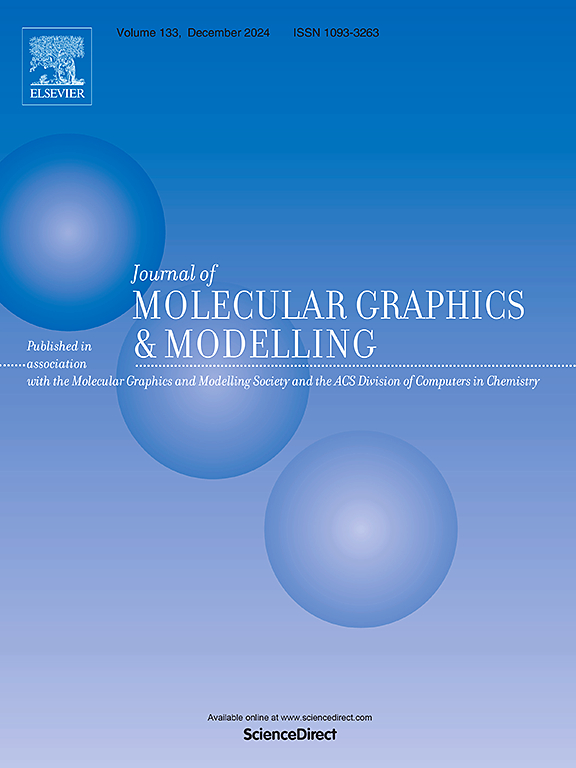The role of donor units in band gap engineering of donor–acceptor conjugated polymers
IF 3
4区 生物学
Q2 BIOCHEMICAL RESEARCH METHODS
引用次数: 0
Abstract
Most used 60 distinct electron-donating units have been modelled, analyzed, and compared using density functional theory (DFT) for tetramer structures in the form (D–B–A–B)4 with fixed acceptor and bridge units, where D, A and B represents donor, acceptor and bridge, respectively. The frontier orbitals and reorganization energy of tetramers with alternating donor units were analyzed to assess their potential applicability in organic electronic applications. Key structural properties including dihedral angles between the acceptor, donor, and bridge units, bond order, and bond length alternation were found to significantly influence the frontier electronic energy levels affecting the planarity, conjugation and electron delocalization of polymer backbone. While extended conjugation and planar structures generally lower the band gap; the specific electronic impact of substituents, such as methoxy or fluorine groups, depend on their position and interaction within the conjugated system. Similarly, the incorporation of heavier heteroatoms, such as selenium, germanium or silicon, introduces steric and electronic effects that can either enhance or disrupt π-conjugation due to the change in the strength of donor unit. Additionally, substitution effects and morphological variations in donor units play a crucial role in defining the physical properties of D-A conjugated polymers. This study establishes a benchmark by providing essential insights into the band gap engineering and the molecular design of D-A copolymers by alternating donor units, thereby supporting significant advancements in organic electronic applications.

给体单元在给体-受体共轭聚合物带隙工程中的作用
使用密度泛函理论(DFT)对(D - B - A - B)4形式的四聚体结构进行了建模、分析和比较,其中D、A和B分别代表供体、受体和桥。分析了具有交替供体单元的四聚体的前沿轨道和重排能,以评价其在有机电子应用中的潜在适用性。关键的结构性质,包括受体、给体和桥单元之间的二面角、键序和键长交替,对影响聚合物主链平面度、共轭和电子离域的前沿电子能级有显著影响。而扩展共轭和平面结构普遍降低带隙;取代基(如甲氧基或氟基)的特定电子影响取决于它们在共轭体系中的位置和相互作用。同样,较重的杂原子,如硒、锗或硅的掺入,引入空间和电子效应,由于给体单位强度的变化,可以增强或破坏π共轭。此外,给体单元的取代效应和形态变化在确定D-A共轭聚合物的物理性质方面起着至关重要的作用。本研究通过提供带隙工程和D-A共聚物的交替供体单元分子设计的基本见解,从而建立了一个基准,从而支持有机电子应用的重大进步。
本文章由计算机程序翻译,如有差异,请以英文原文为准。
求助全文
约1分钟内获得全文
求助全文
来源期刊

Journal of molecular graphics & modelling
生物-计算机:跨学科应用
CiteScore
5.50
自引率
6.90%
发文量
216
审稿时长
35 days
期刊介绍:
The Journal of Molecular Graphics and Modelling is devoted to the publication of papers on the uses of computers in theoretical investigations of molecular structure, function, interaction, and design. The scope of the journal includes all aspects of molecular modeling and computational chemistry, including, for instance, the study of molecular shape and properties, molecular simulations, protein and polymer engineering, drug design, materials design, structure-activity and structure-property relationships, database mining, and compound library design.
As a primary research journal, JMGM seeks to bring new knowledge to the attention of our readers. As such, submissions to the journal need to not only report results, but must draw conclusions and explore implications of the work presented. Authors are strongly encouraged to bear this in mind when preparing manuscripts. Routine applications of standard modelling approaches, providing only very limited new scientific insight, will not meet our criteria for publication. Reproducibility of reported calculations is an important issue. Wherever possible, we urge authors to enhance their papers with Supplementary Data, for example, in QSAR studies machine-readable versions of molecular datasets or in the development of new force-field parameters versions of the topology and force field parameter files. Routine applications of existing methods that do not lead to genuinely new insight will not be considered.
 求助内容:
求助内容: 应助结果提醒方式:
应助结果提醒方式:


